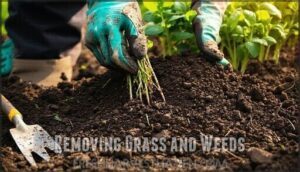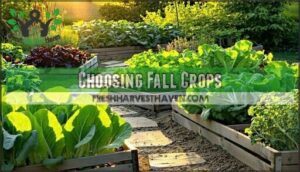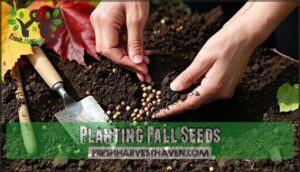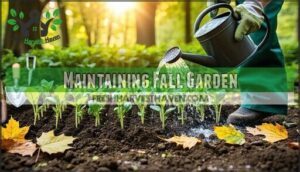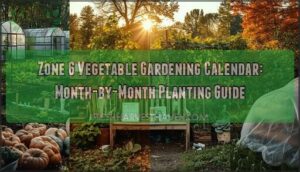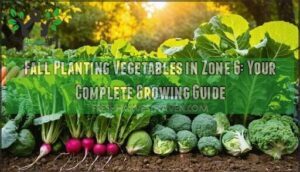This site is supported by our readers. We may earn a commission, at no cost to you, if you purchase through links.
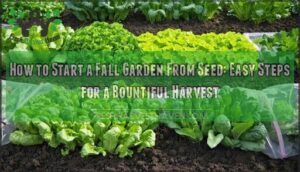
Plant seeds according to packet instructions, keeping soil consistently moist during germination. Most fall crops need 10-12 weeks to mature, so count backward from your first frost date to determine planting time.
Use row covers to protect seedlings from temperature swings and extend your growing season. The secret lies in proper timing and selecting crops that actually taste better after experiencing cool nights.
Table Of Contents
Key Takeaways
- Time your planting backward from the frost date – Count 10-12 weeks before your first frost to determine when you’ll start seeds, giving cold-hardy crops enough time to mature before winter hits.
- Prep your soil properly first – Clear out spent summer crops, add 2-3 inches of fresh compost, and remove weeds to give your fall seeds the best foundation for strong growth.
- Choose cold-loving vegetables – Focus on crops like lettuce, spinach, kale, and radishes that actually taste sweeter after experiencing cool nights and light frosts.
- Protect seedlings with covers and consistent care – Use row covers for temperature protection, maintain steady soil moisture, and monitor for pests to extend your growing season successfully.
Preparing Fall Garden
You’ll need to clear out summer crops, add compost, and remove weeds to get your garden ready for fall planting. These steps help freshen up your soil and make sure your new seeds have the best chance to grow.
Clearing Summer Crops
Your grandmother might have said "out with the old, in with the new," but she was definitely onto something when it comes to fall garden prep. Time to yank those tired tomato plants and spent bean vines—your soil will thank you, and you’ll head off next year’s pest problems before they start.
Here’s the deal with cleanup: anything diseased goes straight to the trash, not your compost pile. But those healthy plant remains? They’re gold for building up your soil. Keep those tools sharp while you’re at it—dull blades make everything harder.
Don’t forget the basics:
- Plan your crop rotation for next season
- Get those weeds out by the roots
- Scout for any pests still hanging around
Adding Compost and Kelp
After that, add some dried kelp to the mix. This ocean-derived amendment delivers trace minerals that most soils lack naturally, creating better nutrient balance for your plants.
Follow up with a compost tea watering—this liquid gold gets the beneficial microbes active again.
Give your amended soil about two weeks to integrate before you plant seeds with your go-to seed starting mix.
After clearing out summer crops, it’s time to treat your soil to a fresh start. Compost benefits are huge—think of it as breakfast for your garden. Spread 2-3 inches of compost across your beds to boost soil health and set the stage for strong Fall Seed Starting.
Next, grab some dried kelp. Kelp application brings trace minerals your plants can’t get anywhere else, helping with nutrient balance. Don’t forget to water with compost tea; it wakes up those good microbes. Let everything settle for a week or two before you start seeds using your favorite Seed Starting Mix.
- Compost benefits: improves texture, adds nutrients
- Kelp application: supplies minerals for growth
- Nutrient balance: helps plants thrive
- Soil health: fosters root development
- Amendment timing: wait 1-2 weeks before planting
Your soil’s ready for the next step in your Seed Starting Guide.
Your fall garden’s soil doesn’t have to stay worn out. Start by testing what you’re working with—soil pH and nutrient levels tell the real story. When phosphorus runs low, bone meal works wonders. Kelp meal adds those trace minerals that make the difference between okay plants and thriving ones.
Timing your compost additions right makes all the difference. Layer in organic matter early so it has time to settle and integrate before you start planting. This gives your soil the structure it needs for strong root development.
Good soil prep now pays off through the entire growing season. Your fall crops get the foundation they need to establish quickly and weather whatever comes their way.
The right Compost Types and Amendment Timing matter, so layer in organic matter early and let it settle before Seed Starting. This way, your soil is primed for Seed Starting Mix and strong root growth.
Smart Soil Preparation and Care set the stage for Fall Seed Starting success, giving your crops a foundation that’s built to last.
Removing Grass and Weeds
A little elbow grease goes a long way in fall garden prep. Start with weed identification so you know what you’re up against. Manual removal is your best bet—grab a garden fork and get those roots. For stubborn patches, soil solarization with clear plastic can help. Herbicide use is an option for tough perennials, but use it sparingly. Don’t forget to remove grass clumps completely. Afterward, prevent regrowth by mulching. Follow these gardening tips for solid soil preparation and care, and you’ll set the stage for successful seed starting in your fall garden.
- Identify weeds before pulling
- Use manual removal for most weeds
- Try soil solarization for tough spots
- Apply herbicide only when necessary
- Mulch to prevent regrowth
Starting Fall Garden Seeds
For seeds to sprout properly, you’ll want to keep the soil between 65-75°F and maintain steady moisture levels.
If germination isn’t going well, try adding grow lights or switching to a quality seed-starting mix to give your seeds the boost they need.
Getting your fall garden seeds started indoors takes the guesswork out of Fall Planting. Begin Indoor Seed Starting 6-8 weeks before your first frost date using quality Fall Seed Varieties.
Seed Starting requires consistent 65-75°F soil temperature and proper moisture for successful germination. Combat Germination Challenges by using Seed Starting Strategies like grow lights and seed-starting mix.
After Seedling Hardening Off over 7-10 days, transplant outdoors. Direct Sowing Tips work too, but indoor starts give Cool Season Crops better success rates.
Choosing Fall Crops
You’ll want to pick vegetables that can handle cool weather and grow quickly before winter arrives.
Focus on cold-hardy crops like lettuce, spinach, and kale, plus fast-growing options like radishes that mature in just a few weeks.
Once your seeds are in the ground, it’s time to think about which varieties will actually handle what winter throws at them.
Cool-season vegetables aren’t just tough—they get better in cold weather. Frost actually makes many of these crops taste sweeter, which is why starting them in fall pays off.
Now that you’ve got your seeds started, selecting the right frost-resistant varieties becomes your next step. These cool-season vegetables don’t just survive cold weather—they actually thrive in it. Many cold-hardy crops develop sweeter flavors after experiencing light frosts, making them perfect for fall seed starting.
Understanding your hardiness zones helps you choose vegetables that’ll handle your specific winter conditions. Cool season crops like kale, Brussels sprouts, and collards can withstand temperatures well below freezing when properly established.
Here are three top performers for overwintering techniques:
- Kale – survives down to 0°F and tastes sweeter after frost hits
- Brussels sprouts – develops rich, nutty flavors in cool weather
- Spinach – perfect for cold frame gardening and winter harvests
Succession planting these varieties every few weeks ensures continuous harvests throughout the colder months.
Fast-Maturing Crops
When planting Quick Crop Varieties, timing becomes your best ally for Fall Harvest Timing. Succession Planting lettuce every two weeks ensures continuous harvests.
Coolseason Vegetables like broccoli and lettuce thrive when Soil Temperature Impact drops below 70°F, offering natural Pest Resistance.
Fall Seed Starting works best with these rapid producers:
| Crop | Days to Harvest |
|---|---|
| Radishes | 25-30 days |
| Arugula | 30-40 days |
| Spinach | 40-50 days |
Root Crops and Greens
Root Crop Sweetness reaches its peak when frost touches your Fall Garden. Carrots, beets, and parsnips develop amazing flavor as temperatures drop. Fall Sowing root crops now means sweet, tender vegetables all winter long. Your Fall Planting efforts pay off with nutrient-rich harvests.
For Overwintering Greens, plant kale and spinach – their Greens Cold Hardiness copes with winter like pros. These crops offer natural Pest Resistance in cooler weather.
Start Seed Starting these coolseason vegetables 8-12 weeks before frost. Succession Planting every two weeks extends your harvest window.
Suitable Flowers for Fall
While root crops sweeten after frost, fall flower colors paint your garden with vibrant blooms. Choose frost-tolerant flowers like calendula for cool season gardening success.
These hardy annuals thrive in fall container gardens while attracting pollinators before winter arrives. Start seed starting indoors six weeks before your fall planting date for best results in your fall garden.
Planting Fall Seeds
Once you’ve chosen your fall crops, it’s time to get those seeds in the ground using proper techniques that’ll set them up for success.
Pay close attention to seed packet directions and soil temperature to give your fall garden the best chance to thrive before winter arrives.
Your seed packets hold everything you need to know for successful fall planting. Take a close look at sowing depth, watering needs, and sunlight requirements – these details make all the difference for germination rates and seed viability.
Here’s how to give your seeds the best start:
- Check if your seeds need seed stratification first
- Plant them at exactly the right depth shown on the packet
- Follow the watering guidelines to keep moisture just right
- Give seedlings the light they’re asking for
- Count the days to maturity so your seed starting and planting timing works out
Pay attention to these basics and you’ll see your seeds take off.
- Track days to maturity for seed starting and planting timing
These details help your seeds sprout successfully.
Understanding Soil Temperature
Your soil thermometers tell the real story about germination temperatures. Most fall seeds need soil between 50-75°F for best ranges and successful sprouting. Understanding the impact of weather is key for predicting the best planting times.
Check these factors for seed starting success:
- Measure soil temperature 2-4 inches deep using reliable soil thermometers
- Track readings for three consecutive mornings for accuracy
- Consider mulch effects on soil warming and cold acclimation patterns
- Adjust timing based on soil health rather than calendar dates alone
Proper Spacing and Air Circulation
When starting fall seeds, proper plant spacing works like good city planning. Give each plant enough room so they’re not competing for resources or blocking each other’s light and air.
Now that you’ve got your soil temperature right, let’s talk about giving your fall garden plants room to breathe. Spacing for Growth isn’t just about following seed packet instructions—it’s about creating the perfect environment for your Seedlings to thrive.
When you’re Seed Starting your Fall Garden, think of proper Plant Density like arranging guests at a dinner party. You want everyone comfortable, not squeezed together fighting for elbow room.
Plant Type Spacing Distance Airflow Benefits
Good spacing delivers real Airflow Benefits that keep diseases at bay. When air moves freely between plants, moisture doesn’t get trapped on leaves. This simple Vegetable Gardening tip provides excellent Disease Prevention.
Don’t forget about Vertical Gardening options for compact spaces. These Gardening Tips help get the most from your harvest while maintaining proper plant spacing.
Using Row Covers and Mulch
After spacing your fall garden seeds properly, you’ll want to protect them from weather swings. Row covers and mulch work like a tag team for your fall garden success. Row covers act as lightweight shields against frost while still letting sunlight reach your plants. Mulch works below ground, keeping soil temperatures stable and locking in moisture.
These two tools give you serious advantages for seed starting and fall gardening tips:
- Choose breathable fabric row covers for frost protection without overheating plants
- Apply 2-3 inches of organic mulch around seedlings for moisture retention
- Use straw or shredded leaves for effective weed suppression
- Combine both methods for reliable pest control against insects and small animals
- Remove row covers during warm days to prevent soil warming issues
This combo extends your growing season and keeps your fall crops thriving through temperature drops.
Maintaining Fall Garden
Once you’ve planted your fall seeds, you’ll need to keep them healthy with regular care and attention.
Check your garden daily for watering needs, pests, and weeds to make certain your crops grow strong before winter arrives.
Consistent Watering and Soil Moisture
Your fall garden thrives with steady moisture monitoring. Check soil by pressing your finger one inch deep—dry means it’s watering time.
Deep watering works better than light sprinkles across different soil types. Mulch benefits include moisture retention and temperature control for successful seed starting.
Adjust watering frequency based on weather conditions to help your fall garden’s growth.
Monitoring for Pests and Weeds
After establishing proper watering, keep your fall garden healthy with smart pest identification and weed control. Cool weather brings fewer problems, but weekly garden hygiene checks prevent issues.
Your preventative measures should include:
- Pulling emerging weeds before they spread their seeds
- Checking leaves for common fall pests like aphids
- Encouraging beneficial insects with diverse plantings
- Using organic solutions like neem oil when needed
These simple gardening tips keep your vegetable gardening thriving without harsh chemicals.
Extending The Growing Season
With winter approaching, your Fall Garden doesn’t need to surrender to frost. Season Extension techniques can add weeks to your growing season. Row Covers and Cold Frames create protective microclimates, while Overwintering Crops like kale actually improve after light frost. Smart Weather Protection keeps your Harvest Extenders producing longer. One key element is to make sure garden soil is moist before a freeze.
Essential season extension strategies:
- Install row covers for 2-8°F of Frost Protection
- Build simple Cold Frames using old windows
- Use Shade Cloth in late summer for better Seed Starting
- Apply thick mulch around plants for root insulation
Harvesting and Enjoying Fall Crops
Your fall harvest rewards months of careful planning. Pick leafy greens in the morning when they’re crisp and full of moisture. Use cut-and-come-again harvesting techniques with lettuce and spinach for continuous yields.
Frost sweetness makes carrots and beets incredibly flavorful after light freezes. Store root crops in cool, dry places to preserve freshness.
Try overwintering spinach in cold frames for early spring harvests. Transform your bounty into hearty fall crop recipes and share the abundance with neighbors.
Frequently Asked Questions (FAQs)
Too many gardeners get caught off guard when fall rolls around, realizing they’ve waited too long to start their autumn crops.
Nearly 40% of gardeners miss their fall planting window by starting too late.
You’ll need to count backward from your first frost date, then start seeds indoors 6-8 weeks earlier or direct sow outdoors according to each crop’s specific timing requirements.
Should you start seeds indoors for a fall garden?
You can start seeds indoors for certain fall crops. Begin broccoli and cauliflower indoors six to eight weeks before your first frost date. This gives them time to develop strong roots before transplanting outside.
Most fall-planted vegetables will reach harvest before winter arrives – you’ll typically see success rates around 85% or better in most growing zones.
Over 85% of vegetables planted in fall mature successfully before the first frost hits.
You should plant seeds in fall because cool-season crops thrive in autumn temperatures and often taste better after light frost touches them.
How do you plan a fall garden?
Check your frost date first, then choose quick-growing, cold-hardy crops like spinach and radishes. Clear spent summer plants, add compost, and time plantings so they’ll mature before hard freeze hits.
When should you plant a garden in the fall?
Plant your fall garden 10-12 weeks before your first expected frost date. Cool-season crops like lettuce, spinach, and radishes thrive when temperatures drop below 70°F consistently.
Here’s the thing about fall gardening: timing kills most people’s success before they even start.
Most gardeners miss 90% of their fall harvest potential by planting too late.
You’ll want to count backwards from your first frost date, then start seeds 6-18 weeks earlier depending on the crop’s maturity time.
How do I plan what to plant in my Fall Garden?
Start by knowing your first frost date, then work backwards. Choose cold-hardy crops like kale, spinach, and carrots that thrive in cooler weather. Select fast-maturing varieties to beat hard freezes.
How do I start a fall garden vegetable garden?
Clear out summer crops and add compost to refresh your soil.
Choose cold-hardy vegetables like lettuce, spinach, and radishes. Time your planting around your area’s first frost date for best results.
When should I plant flower seeds?
Timing matters more than you think! You’ll want to plant flower seeds in spring after the last frost date passes, or start them indoors 6-8 weeks earlier for a head start.
Can you plant vegetable seeds in the fall?
Yes, you can plant vegetable seeds in fall! Choose cool-weather crops like lettuce, spinach, radishes, and carrots. Plant them 8-12 weeks before your first frost date for best results.
Fall gardening from seed is straightforward once you get the timing right. You don’t need perfect conditions—just plan backward from your first frost date and give your plants enough time to mature.
Conclusion
Like autumn leaves falling to nourish the earth below, your fall garden seeds represent renewal and preparation for seasons ahead. Starting a fall garden from seed doesn’t require flawlessness—just patience and proper timing.
Fall gardening from seed requires patience and timing, not perfection
You’ve learned the essentials: clearing space, enriching soil, choosing hardy varieties, and protecting young plants. Remember to count backward from your first frost date when planning.
With consistent watering and attention to detail, you’ll soon harvest crisp greens and flavorful vegetables that actually improve with cooler weather.
- https://www.gurneys.com/collections/fall-harvest-vegetables
- https://marylandgrows.umd.edu/2020/07/03/time-to-think-about-fall-planting/
- https://www.reddit.com/r/vegetablegardening/comments/14q1qe6/thinking_of_doing_some_fall_gardening_when_it/
- https://blog.acmetools.com/prepping-your-garden-soil-in-the-fall/
- https://phsonline.org/for-gardeners/gardeners-blog/prepare-garden-soil-fall-for-spring-planting



